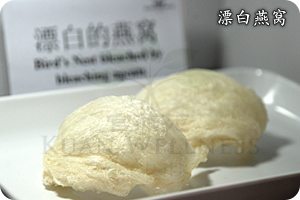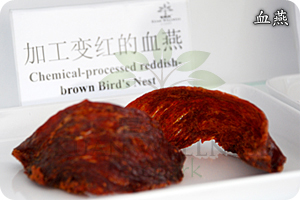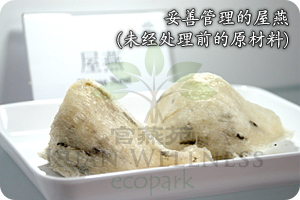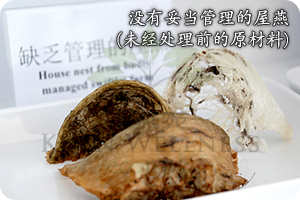1. How many types of bird’s nest are there in the market?
Bird’s nest can be generally categorized into 2 types, edible and non-edible. The non-edible bird’s nests are composed of soil, mud or leave and twig while the edible bird’s nests contain the sticky saliva of swiftlets. The edible bird’s nests are acquired from the swallows from the Southeast Asia in the name of “Golden Swiftlets”.
2. What are the nutrition facts of bird’s nest?
From the nutritionists’ analysis, the main composition of bird’s nest is glycoproteins including proteins and carbohydrates. There are also minerals content like calcium, magnesium, potassium and iron. Besides, bird’s nest contains amino acids that promotes growth of human cells and regeneration of biologically active substances. Hence, it is especially good for chemotherapy patients or those who have damage in skin tissues. Medical studies shown that bird’s nest contains Epidermal Grow Factor (EGF) that promotes human cell reproduction, regeneration, tissue reconstruction and good for the digestion system as well as promoting effective anti-aging. Consumption of bird’s nest could also enhance nourishment of lung and helps to alleviate cough. On top of that, it is also known for its revitalizing effect and prolonging longevity.
3. Is there a difference in quality in between bird’s nest acquired from the cave swiftlet and the house swiftlet?
The bird’s nest from cave swiftlet is acquired from the caves. The color of this bird’s nest is slightly reddish due to the red mud on the rock surface. As environmental pollution issues are increasing, the bird’s nest from cave swiftlet might possibly contains heavy metal substances. On the other hand, bird’s nest from cave swiftlet contains more fine feathers and the shape of nest is normally incomplete. The texture of this bird’s nest is more condensed and as a result, the expansion level is restrained and required longer period of soaking and cooking.
Swiftlet house is a specially designed structure which provides ideal shelter for the swiftlets to grow healthily and hence producing bird’s nest of better quality.
4. What is a poor quality bird’s nest?
A poor quality bird’s nest refers to those which have been chemically processed including fake bird’s nest and dyed bird’s nest with swallow’s feces or chemical dyes. For greater profit margins, some unethical businessmen even replace bird’s nest with processed seaweed, pigskin, bean threads and white fungus. There are also businessmen who used bleaching agents to bleach the poor quality bird’s nest or add in starch to the bird’s nest to increase weight. These artificially and chemically processed bird’s nests contain excessive nitrite which might lead to cancer. Conclusively, these bird’s nests are not only lack of nutrition value but also lead to severe damage to health.
5. Is the quality of all the house nests the same?
As a matter of fact, the quality of bird’s nests has a direct relation to design and management of the swiftlet house. Bird’s nests that acquired from a professional swiftlet farm contain less impurity. Hence, the cleaning process will be less complicated where the nutrients will be well conserved in the bird’s nests.
Moreover, the age and experience of swiftlet are also directly related to the quality of bird’s nests. As a swiftlet grow older and became more experienced, it tends to seek for better quality of food as well as building a better quality of nest. Therefore, the bird’s nest built by a mature swiftlet is thicker, more condensed, more complete in shape and better in quality. Conversely, bird’s nest built by young swiftlet is incomplete in shape, smaller in size and less condenses.
6. Why Kuan Wellness Bird’s Nests are better in quality?
Kuan Wellness owns a swiftlet eco park, a number of swiftlet farms as well as a bird’s nest processing centre. We ensure all our swiftlet farms are operating according to the ISO9001 standard of operations. Hence, our bird’s nests are high in purity and require simple cleaning process where the nutrients will be well conserved in the bird’s nests. Chemicals, bleaching agents, colorings, starch or other additives are strictly prohibited throughout the process of our bird’s nests. The entire process is stringently controlled in pest, water quality and bacteria, and it is operated by our well trained workers according to the internationally recognized standard ISO 22000(Food Safety Management System).
7. What is special at Kuan Wellness Eco Park?
In Malaysia, Kuan Wellness Eco Park is a first-of-its-kind bird’s nest ecology park, established with ecotourism as its primary mission and objective. With a total land area of 5 acres, the ecology park consists of a 3½ storey swiftlet farm and a visitor centre, surrounded by palm oil plantations and tropical fruit farms which provide plenty of insects, the swiftlet's favourite food source. The visitor centre is equipped with car park, restrooms, reception lobby, swiftlet gallery, eco theatres, bird nest processing and research centre, sales centre, smoke-free bird nest eco café, eco-garden, green promenade and more interesting features to be explored. Interesting documentary videos on the swiftlet’s natural habitat will be shown to the visitors for a deeper understanding of swiftlet living and the nutritional value of bird’s nest while the respective health concerned messages will be delivered at the same time. On top of that, visitors could enjoy the delicacy of bird’s nests soup at our café and purchase our high quality bird’s nests from our sales centre.
8. What is it about the documentary?
The documentary videos are about swiftlet’s natural habitat and they open to the public for free for a deeper understanding of swiftlet living and the nutritional value of bird’s nest while the respective health concerned messages will be delivered at the same time.
9. Why swiftlet houses are built at the plantations?
Swiftlet houses are normally set up in secondary or the third important town due to the abundance supply of food to the swiftlets and the pollution level is lower. These swiftlet houses are strategically located for the convenience of maintenance and collection of bird’s nests. The swiftlet houses are mostly set up nearby the plantations due to the abundance supply of food to the swiftlets. In addition, as a result of the excellent growing conditions for the swiftlets at the suburban areas, the bird’s nests produced are high in quality.
10. Where is Kuan Wellness Eco Park located and what are the nearby attractions?
The Kuan Wellness Eco Park is strategically located at Tanjung Sepat, between Sepang Goldcoast and Morib Gold Coast, which is about 75 minutes from Kuala Lumpur, 45 minutes from Putrajaya and 30 minutes from KLIA. Tanjung Sepat is an ideal tourist spot for day trip. An escape from the hectic city life and experience the simplicity of a small villag, visitors could also visit the Ganoderma lucidum (or commonly known as the Lingzhi mushroom) farm, fruits gardens, fish ball factory, tapioca crackers factory, buns factory, coffee powder factory, the lovers’ bridge and also enjoy delicacy of fresh seafood dishes and the authentic snacks in Tanjung Sepat.









